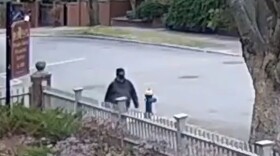On a recent Sunday, Kate Bagnati approached an old, cream-colored rotary phone sitting in a grove of trees outside the historic Ridgebury Congregational Church in Ridgefield.
She picked up the receiver, dialed a number, and started talking.
“Hey mama,” she cried into the phone. “I miss you.
“I know you’re around. But this is a pretty cool way to talk.”
Bagnati’s mom, Grace, died about a year ago. The phone she’s using isn’t connected to a telephone line. It’s a “wind phone,” a disconnected phone that people can use to have one-way conversations with their loved ones who’ve died.
“It is a means by which to have the conversations you didn’t get to have — the good, the bad, the ugly — and know that the wind will carry them to the source that needs to receive them,” said Rev. Deborah Rundlett, pastor at the church, which recently set up a wind phone.
Ridgefield’s wind phone is the first in Fairfield County — and one of three in Connecticut, according to one estimate.
The phone in Ridgefield is attached to a wooden post with a little roof, at the end of a gravel path. There’s a bench next to it. A plaque above it reads: “This phone will never ring. It is connected by love to nowhere and everywhere. It is for those who have an empty place in their heart left by a loved one. Say hello, say goodbye. Talk of the past, the present, the future. The wind phone will carry your message.”
A place to normalize grief
Lynda Shannon Bluestein and her son Jacob Shannon are the brains behind the Ridgefield wind phone. They approached Rev. Rundlett about bringing the phone to her church. Bluestein has terminal cancer and is in hospice care. Earlier this year, she made national headlines after successfully suing the state of Vermont to drop its residency requirement for medical aid in dying.
Bluestein wants the wind phone to be a space for normalizing grief.
“I don’t think that when my body dies that’s the end of me,” she said. “I think there’s so much more, and I want them to know we’re still connected by love. I saw having a wind phone here as a place where my family and friends can go and keep me alive.”

In recent years, more than 150 wind phones have popped up across the United States, according to My Wind Phone, which locates and lists wind phones.
Amy Dawson created the website a year and a half ago to honor her daughter Emily, who died in April 2020.
“Grief gets swept under the carpet,” she said. “People get three bereavement days if they lose their spouse, their family member, their child. Like are you kidding? And you’re supposed to move on? But you don’t move on, you move forward.”
An idea born in Japan and out of grief
The first wind phone dates back to 2010, more than 6,000 miles away in Ōtsuchi, Japan.
A garden designer, Itaru Sasaki, is widely credited as being the creator. He was mourning the loss of his beloved cousin, so he set up an old-fashioned phone booth in his garden with an unconnected rotary phone inside. It helped him cope with his grief. A year later, an earthquake and tsunami devastated the region. Sasaki opened his wind phone to the public, and it became a place of solace for thousands of visitors.
Bluestein hopes to do the same thing in Connecticut. In her dining room, she has a collection of rotary phones in different colors, all waiting for a home. She thinks of these wind phones as her legacy — something tangible her friends, family, and even strangers can use to stay connected to those they’ve lost.
“I don’t have a lot of time left,” she said, “but I have a lot of ideas about where I would like wind phones to be around Fairfield County.”





